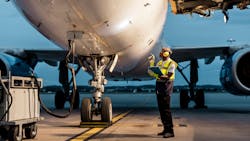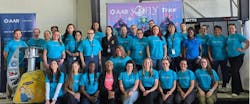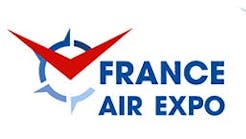Future Proof the Maintenance Operation and Address Increasing Tech Shortage
Like other sectors of the aviation industry, aircraft maintenance too felt the weight of the pandemic and related safety precautions and cost-saving measures. Through it all, however, advancements in line maintenance continued. Recognizing that unplanned maintenance is one of the main causes of flight delays, it has been targeted by progressive airlines that understand the value of leveraging advanced technologies like Artificial Intelligence (AI), machine learning, proprietary algorithms, the Internet of Things (IoT) and even augmented reality (AR). Here is a look at how these technologies are improving line maintenance operations and some of the latest developments in leading-edge optimization software.
Unplanned Maintenance, Technician Shortages and Technology
Among the top causes of flight delays are unplanned maintenance activities, for example, a problem with an airplane’s engine fan blades, fuel contamination or contamination of its air conditioning system. Given the strict technical maintenance requirements aircraft must adhere to, some flight delays are unavoidable. Maintenance, like crew scheduling, flight preparation activities (e.g., cleaning the aircraft, baggage and catering loading), is, however, one of those items under an airline’s control unlike extreme weather or terrorist activities. While not every malfunction is easily prevented or detected, many are with a sound predictive maintenance initiative.
According to data from the U.S. Bureau of Transportation, in 2019, U.S. airlines experienced 302 tarmac delays which lasted longer than three hours. This statistic compares with comparable delays in 2018 and 2017 which numbered 202 and 193, respectively. Unplanned maintenance was cited as a main cause of these lengthy delays not just in the U.S. but worldwide. It is true that a shortage of qualified aircraft maintenance technicians (AMT) has been an industrywide problem. Currently, the Aviation Technician Education Council reports that new technicians entering the field represent only 2 percent of this workforce, and 33 percent of the current AMT workforce is at or near retirement age. A Boeing forecast estimated that there will be a global demand for 739,000 new technicians in commercial aviation through 2039. The 2019-2029 Oliver Wyman Global Fleet and MRO Market Forecast estimated the shortage of AMTs to increase by 9 percent. In the face of this projected shortfall, technology can be a tremendous resource for optimizing processes, boosting productivity and enabling technicians and other staff involved in aircraft maintenance operations to worker smarter, faster and more cost-effectively.
AI Tracks Aircraft Requirements, Generates Work Orders
Leading airlines are embracing technology from AI and machine learning to proprietary algorithms, AR and IoT, not just to maximize productivity, but also to optimize their maintenance processes. Specifically, to address the unplanned maintenance problem, they are replacing manmade decisions with AI- and machine learning-informed decisions to enhance the most critical aspects of line maintenance. These include long-term staff scheduling using rule-based function to determine workload based on the number of aircraft, flight schedules, new aircrafts, workers’ skills, modifications to labor agreements, etc. Driven by these technologies, which rely on rule-based functions, optimized staff schedules that take into account technicians’ skills, schedules, vacation and time-off preferences can be generated. As for unexpected occurrences, the technology steps in to drive the optimum response that helps minimize technical delays and supports heightened productivity. Easy to access information is delivered via mobile platforms which facilitate the tracking of each task to be performed and enables key performance indicators (KPIs) to be closely monitored.
Enhancing Parts Management, Tracking Defects
As for parts management, machine learning can support normal processes relating to parts exchanges with information learned from malfunctions or accidents taken into account. Then, this information can be incorporated into new learned actions and rules and entered promptly and easily into today’s leading-edge software in order to implemented updated standards.
Among the newer features in the most advanced software is one which helps track defects for each aircraft and then enables that information to generate the next generation of tasks to be performed. Using the software, dispatchers can gain a dedicated aircraft view which supports their better focus on each aircraft’s workload, the engineers deployed and the overall task allocations. Through the software’s overview view, a visual representation of all relevant aircraft on the current maintenance schedule and their maintenance progress is readily accessible.
Another advancement in optimization software is a new task generator that enables better management of special aircraft change and aircraft on ground (AOG) situations that require a fast response to access parts, make repairs and return the aircraft to service. For recurring tasks, this feature provides improved automatic selection and rescheduling of recurring maintenance checks in case of a disruption. Improved mobile phone dialogues further support engineers’ workflow and make it easier for them to monitor aircraft maintenance progress when they are not physically on an aircraft.
Planning Maintenance in Concert with Flight Programs
At the Netherlands Aerospace Laboratory, an AI-based solution has been developed to enable airlines to better plan their maintenance functions based on their flight schedules. The solution was designed to minimize aircrafts’ out of service and preparation times. Its AI algorithms use maintenance planning documents, aircraft configurations, maintenance status, etc. The information is then consolidated into work plans that can be inserted in between flights and can be modified to accommodate unexpected changes in the flight schedule. Operators benefit from the reduced time needed to manually prepare maintenance programs and the resulting increase in productivity.
Similarly, AI has proven to be a major asset in supporting the improved coordination of aircraft maintenance tasks. The deployment of AI-driven software provides maintenance departments with important historical data, real-time data, notifications and reports that facilitate optimized processes, for instance, ordering spare parts on time, keeping customer service departments information regarding any maintenance-related operations that might affect flights so that a flight plan can be adjusted, etc.
Machine learning too can be used in this way by capitalizing on information embedded in various data sources that help identify, for instance, repeated failure patterns related to a specific component, and make this important insight available to maintenance and other departments. By capturing previously untapped data, machine learning elevates the maintenance operation to help intercept possible problems and reduce unplanned maintenance.
New tasks generated from what if scenarios also are supported by optimization software driven by AI, machine learning and advanced algorithms. When the pandemic ushered in new safety protocols, this software was able to generate the disinfection of entire aircraft cabins for every ground time, automatically planning and executing this task in conjunction with basic or complex schedules. When aircraft has to be stored for prolonged periods, the software is able to quickly generate a set of specific tasks to prepare the aircraft (e.g., electrically ground the aircraft, install plugs and engine covers, apply temporary protective coatings, etc.). Additionally, recurring activities necessary during storage (e.g., moving the aircraft to prevent tire flat spots, checking and/or recharging batteries, periodic powers ups to check systems, periodic water drainage, etc.) can be automatically generated according to schedule. Then, once the lengthy storage period concludes, the software can generate specific tasks for its airworthiness and return to service.
IoT and Augmented Reality in Aircraft Maintenance
IoT smart sensors are also providing value in maintenance processes by providing data for early insight into problems prior to their occurring. Using IoT data, potential glitches can be addressed before they escalate into larger issues which pose a threat to flight safety or schedules.
AR, working in conjunction with AI, is being used on smart glasses which help AMTs see hands-free and with interactive 3D wiring diagrams instead of having to view aircraft components on 2D, 20-foot-long drawings. AR has been shown to deliver a 90 percent improvement in first-time repairs and reduce repair times by 30 percent.
Closing Remarks
Aircraft maintenance is gaining a real benefit from advanced technologies even advancing airlines’ sustainability goals by eliminating the abundance of paper associated with manual, paper-based work and task schedules. In addition to helping reduced unplanned maintenance and the associated costs and flight delays, these technologies are increasing worker productivity, helping offset the impacts of AMT shortages and boosting staff satisfaction.






